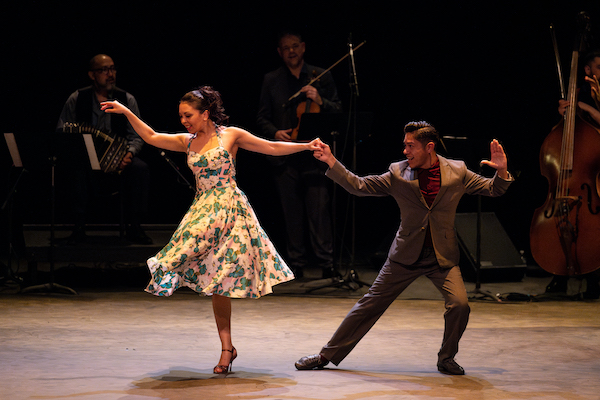Dance Review: The Social Tango Project — Bringing the Tango Back to its Roots
By Charles Giuliano
At the Pillow, the wonderful Social Tango Project brought the form back to its political and aesthetic origins: it is a dance designed to unify and uplift participants and audiences.

The Social Tango Project in action. Photo: Christopher Duggan
Making its first appearance at Jacob’s Pillow, The Social Tango Project presented a very different, more ethnic and folk, version of the traditional dance of Argentina. Perhaps the tango’s misleading branding started with Rudolph Valentino, who ignited the erotic imagination with a machismo fueled approach. That sexuality was intensified by the sensuality of the tango when it became an element in competitive ballroom dancing. We are readily familiar with its memes: stylized postures, abrupt dips and turns, dramatic flourishes.
What we saw on stage at Ted Shawn Theatre was a more indigenous, laid back version of the tango, executed with little theatrical flamboyance. The performance was rooted in the milonga genre (dance party). Artistic director and choreographer Augustina Videla has been with the company since 2013. The small orchestra is led by pianist, composer, and arranger, Fluvio Giraudo. The award-winning dancers include: Lucia Ohyama, Yanina Muzyka, Cinthia Diaz, Ana Zoraida Gomez Diaz, Emmanuel Casal, Roberto Zuccarino, Bruno Maya, Jorge Padilla, Lily Chenelo, and Lucia Aspiroz Larrosa.
The performance began with vintage, black-and-white footage (directed by Nora Lezano) of urban Buenos Aires. This gave way to individuals in trench coats roaming the stage. On impulse, a woman wanders into a club. Once seated at a table off to the side, she observes the dancers. A man invites her onto the floor but, because she does not know the tango, she pulls away and starts to leave.
A woman, a tango instructor, approaches and presents a business card. Later, the stranger returns and she takes her first tango lesson. Back at the club, however, the man who had first approached her is enjoying dancing with other women. Feeling rejected, she attempts to leave. But she is corralled by several women who prevail on her to stay. They explain that it is normal to dance with several partners during an evening.
Of course, that is one of the purposes of social dancing. It is a way for people to compensate for their loneliness, stress, and isolation. Tango represents a vital force that encourages community. At the end of the performance, we are screened a video of several older people who discuss what tango means in their lives. It’s where they go to be with an ever expanding circle of friends. Mischievously, an older man confesses that through tango he has danced intimately with hundreds of women.

A high-flying moment in The Social Tango Project performance. Photo: Christopher Duggan
After three intensive weeks of ballet at Jacob’s Pillow, this show supplied a very different experience. We had to adjust our expectations and accept The Social Tango Project on its own terms. There were none of the astonishing ‘aha!’ moments we have come to expect at the Pillow. But that should not be taken as a judgment — only a way to classify what turned out to be a joyous event. Over an hour and fifteen minutes there were sixteen intervals that intertwined dance and instrumental music. The band was comprised of piano, bass, violin, and bandoneon, an expressive, reedy accordion. At times, a singer accompanied himself on guitar.
While the norm was male and female partners, there were also a female couple and a single instance of men dancing together. This version of the tango was an exercise in touch-dancing: the partners never separate but constantly change leads. The upper body remains rigid; our attention is riveted by the movement of the legs and feet of the women. They often shift their hips in various directions. Another familiar move: a dancer wraps a leg around a partner and then launches into executing some quick kicks. These moves are executed at alternating gaits — slow fluid legato as well as, on occasion, precise warp speed. The dancers maneuvered in a variety of patterns, ranging from rectangular to circular formations, and were generally spread out across the stage.
The highlight of the program occurred mid-way. In the spirit of milogna, the company was joined by a group of tango dancers from Albany. Thus the stage was crowded with dancers for “Maipo” and “Tigre Viejo.” The locals acquitted themselves with skill as they performed with Argentine professionals. The action stopped just short of frenzy when individual couples stepped, with vigor, into the spotlight. It was fascinating to see dancers of all ages and skill levels take such evident pride and joy in their tango prowess.
The Social Tango Project enhances our understanding of how the tango evolved over centuries. Initially it was folk art form, with African roots, taken up by the poor and oppressed. Historian Robert Farris Thompson notes that the “tango started as Black and milonga, the dance that preceded it, even more so.” During the 19th century the tango was associated with sex workers, dismissed by the respectable as a “reptile from the brothel.” Once classes high and low embraced the tango, the dance form eventually absorbed European influences.
Thanks first to Valentino and then to popular TV programs like Dancing with the Stars, the tango went showbiz glitz. At the Pillow, the wonderful Social Tango Project brought the form back to its political and aesthetic origins: it is a dance designed to unify and uplift participants and audiences.
Charles Giuliano is the author of Annisquam: Pip and Me Coming of Age.
